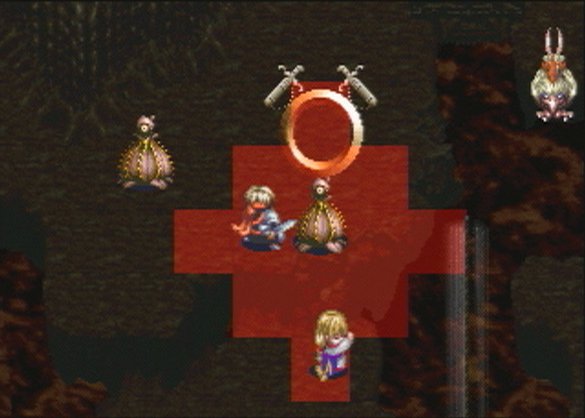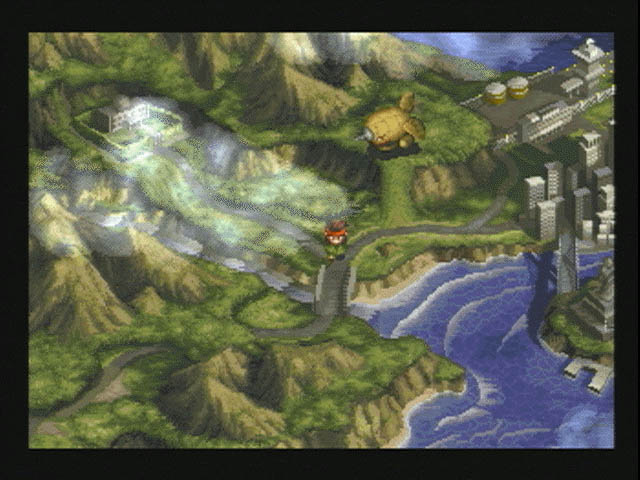|
|

|
PLATFORM
|
PSX
|
BATTLE SYSTEM
|

|
INTERACTION
|

|
ORIGINALITY
|

|
STORY
|

|
MUSIC & SOUND
|

|
VISUALS
|

|
CHALLENGE
|
Unbalanced
|
COMPLETION TIME
|
40-60 Hours
|
|
OVERALL

|
+ Can import data from first game.
+ Decent story.
- Horribly unbalanced combat.
- Normal attacks are *useless*.
- *Long* periods without being able to save.
- Limited inventory space.
|
Click here for scoring definitions
|
|
|
Elc is a young hunter who dreams about his past, where his family and tribe were massacred by soldiers attempting to take the Fire Guardian. He soon becomes involved in a larger chain of events, coming into contact with the fugitive Arc Eda Ricolne and his companions. The G-Craft-developed Arc the Lad II directly continues the first game, essentially being a far more complete title, although this isn't necessarily a good thing, as flaws such as horribly unbalanced combat prevent the second installment from truly excelling.
The second chapter is more of a mainstream RPG than its predecessor, given the addition of things such as fully explorable towns, navigable overworlds for each country and dungeons, and so forth, although it still inherits its predecessor's tactical gameplay, with enemies regularly encountered within said dungeons. This time, battle size is down to five characters, with the player having a much larger selection of allies this time around, and, typically upon entering a dungeon, being able to pick which ones will form the battle party.
Characters and enemies take turns moving across a grid-based field depending upon agility, with both sides able to attack each other normally, use skills on themselves and their opponents, and so forth. It is also possible to escape from combat by approaching exits and choosing to depart the current room, although all the enemies in that particular chamber will respawn if the player returns there, or the player leaves the dungeon completely; however, in most instances, if the player wins a chamber's battle, its enemies will remain dead as the player continues exploration. A minor flaw here is that the player can't move a character across exit without encountering the exit prompt, with refusal forcing that character away from the exit, sometimes a problem when characters are crammed near said exits.
There are, however, deeper problems in combat, such as the fact that, if a character is even one level below the enemy, physical attacks will almost always miss, even when he/she attacks enemies from the sides or behind. As a bonus, just about every enemy can counterattack, sometimes spelling doom for weaker characters. Thus, since characters will mostly be dozens of levels below the enemy, players will be largely dependent on magic throughout the game, which has to be centered on characters or enemies in order to execute. In another lazy design decision, enemies only face the screen when low on HP, a step down from the first game where they faced all four directions when near death.
 Tic-Tac-Toe Attack
Tic-Tac-Toe Attack
|
|
There is, though, a bright side to combat. If the player's party completely dies, that same fight will restart with experience gained kept, at the penalty of half the player's money. Money actually isn't that big a problem at all during the game since upgrading weapons and armor isn't terribly expensive, even if said equipment is more or less ineffective in the toughest battles. Another element exists where the player has to "level up" current weapons and armor by attacking normally or taking damage, although doing the former, given the astronomically high miss rate, can be difficult. Ultimately, Arc the Lad II is far from a shining example of what a tactical RPG's battle system should be, despite its small redeeming aspects.
Interaction has also somewhat suffered during the transition to the sequel, which, for one, imposes a limit on inventory space, another step down from the first installment, where consumable items were stackable and equipment had its own separate inventory. This can especially be a problem if the player imported many items from the first game, often resulting in the need to sell or give up some of it. Moreover, the game often forces players to spend a long time traversing dungeons with very few opportunities to save, up to an hour or so, making the second chapter difficult to play in short bursts. There are also a few times where finding out how to advance the main storyline can be difficult, with doing so sometimes requiring the player to talk to certain NPCs with specific allies. Overall, the interface could have been far better.
Arc the Lad II does certainly deserve some minor points for creativity, being one of the first RPGs to allow data import from its predecessor, although it does to a large extent borrow the first game's mechanisms, expanding upon them somewhat. The second chapter also filches one of its biggest sidequests, guild missions that allow the player to earn some extra money (even if it's no problem whatsoever), from Phantasy Star IV. All in all, the sequel is at best moderately inventive.
The sequel's only saving grace is its story, which nicely expands upon that of its predecessor and includes decent development for a few key characters and occasionally some of the minor characters. Working Designs' translation also doesn't detract terribly from the plot, despite some small errors, and in the end, the sequel's narrative is pretty much all it has going for it.
 Crossroads
Crossroads
|
|
Arc the Lad II's soundtrack is a mix of tracks taken directly from its predecessors alongside new tracks, with the music largely being hit-or-miss, with most of the dungeon tracks being ambivalent and some of the battle tracks being bland (though there are certainly a few good ones), although there are some decent cutscene pieces. As with the first game, moreover, Working Designs left the voice acting in Japanese, with the voices more or less fitting their respective characters, though those with no knowledge of the language certainly won't know what exactly they're saying. Overall, the sequel's sound is mostly average.
Aside from the issue with monsters only facing south when low on HP, the sequel's visuals are an improved version of those from the first game, with scenery and character sprites having a higher resolution (though pixelated close-ups whenever characters and enemies attack normally return). The scenery looks nice (alongside occasional FMVs, despite the lack of characters in them), but sprites are still disproportionate and make characters somewhat resemble hobbits. There are also many palette-swapped enemies, and in the end, Arc the Lad II doesn't have the best graphics on the Playstation nor does it have the worst.
Finally, the sequel is much longer than its predecessor, taking somewhere from forty to sixty hours to complete, given both the power-leveling necessary to conquer the final boss as well as the endless sidequests that could possibly boost playing time beyond that range.
Overall, Arc the Lad II very much builds upon its predecessor, given the addition of deeper town, world, and dungeon exploration, an expanded soundtrack, and more polished visuals, although the gameplay unfortunately suffers, given its terribly unbalanced nature. Little things could have easily improved the sequel, such as normal attacks being more effective, alongside more opportunities to save. Granted, the game does have some redeeming aspects such as a good plot, although great storytelling, frankly, can't compensate for weak gameplay.
Review Archives
|









